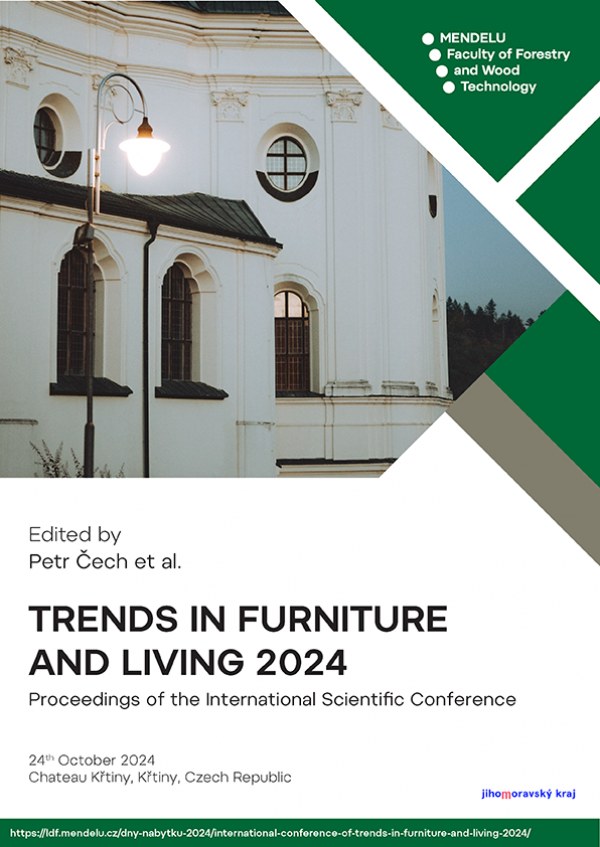
DOI: 10.11118/978-80-7701-044-3-0055
THE RESPONSE OF SCREW CORNER JOINTS MANUFACTURED OF HONEYCOMB PANELS TO CHANGES IN RELATIVE AIR HUMIDITY
- Smardzewski Jerzy1,2, Tokarczyk Maciej1, Giedrius Pilkis2
- 1 Poznan University of Life Sciences, Faculty of Forestry and Wood Technology, Wojska Polskiego 28, Poznan, Poland
- 2 Vilnius Academy of Arts, Maironio g. 3, LT-01124 Vilnius, Lithuania
Honeycomb panels are an attractive material for furniture production. However, their usefulness in industrial practice depends on the technological quality of corner joints and the effect of temperature and relative humidity changes on the stiffness and strength of these joints. This work made corner joints from 37 mm thick honeycomb panels. A screw confirmat type was used for the connection. It was experimentally determined to what extent a change in air relative humidity from 40% to 85% will affect the strength and stiffness of corner joints. Numerical models were developed to predict the behavior of joints in variable climatic conditions. It was shown that an increase in air humidity reduces the stiffness and strength of joints. However, in conditions of extreme humidity of 85%, the stiffness and strength of joints are still acceptable compared to dry conditions (40%). Numerical models allow for correct estimation of the quality of joints.
Klíčová slova: honeycomb, screw joint, air humidity, strength, stiffness, FEM
stránky: 55-62, online: 2025
Reference
- ALLEN, Howard Georg. 1969 Effect of cell-wall angle on the uniaxial crushing behaviour of paper hexagonal honeycombs. New York: Pergamon Press. ISBN 9789532920314
- CARLL, Charles; WIEDENHOEFT, Alex C. 2009. Moisture-related properties of wood and the effects of moisture on wood and wood products. In: Moisture Control in Buildings: The Key Factor in Mold Prevention. ASTM Manual. 2nd Edition. West Conshohocken, PA: ASTM International, c2009. Chapter 4, p.54-79.
- FEIFEL, Silke, POGANIETZ, Witold-Roger; SCHEBEK, Liselotte. 2013. The utilization of light weight boards for reducing air emissions by the German wood industry - a perspective? Environmental Sciences Europe. 25, 5. https://doi.org/10.1186/2190-4715-25-5
 Přejít k původnímu zdroji...
Přejít k původnímu zdroji... - HARKATI, A. et al. 2020. In-plane elastic constants of a new curved cell walls honeycomb concept. Thin-Walled Structures. 149, 106613. https://doi.org/10.1016/j.tws.2020.106613
 Přejít k původnímu zdroji...
Přejít k původnímu zdroji... - KASAL, A. et al. 2008. Effects of screw sizes on load bearing capacity and stiffness of five-sided furniture cases constructed of particleboard and medium density fiberboard. Forest Products Journal. 58(10), 25-32.
- KASAL, A. et al. 2014. Effect of material properties and anchorage location on load-bearing capacity of screw-connected and hung cabinets. Wood and Fiber Science. 46(1), 1-10.
- KASAL, Ali et al. 2023. Analyses of L-Type Corner Joints Connected with Auxetic Dowels for Case Furniture. Materials. 16(13), 4547. https://doi.org/10.3390/ma16134547
 Přejít k původnímu zdroji...
Přejít k původnímu zdroji... - KRZYŻANIAK, Łukasz; MARDZEWSKI, Jerzy. 2021. Impact damage response of L-type corner joints connected with new innovative furniture fasteners in wood-based composites panels. Composite Structures. 255, 113008. https://doi.org/10.1016/j.compstruct.2020.113008
 Přejít k původnímu zdroji...
Přejít k původnímu zdroji... - LAY, Makara et al. 2019. Comparison of physical and mechanical properties of PLA, ABS and nylon 6 fabricated using fused deposition modeling and injection molding. Composites Part B: Engineering. 176, 107341. https://doi.org/10.1016/J.COMPOSITESB.2019.107341
 Přejít k původnímu zdroji...
Přejít k původnímu zdroji... - LIBRESCU, Liviu; HAUSE, Terry. 2000. Recent developments in the modelling and behavior of advanced sandwich constructions: A survey. Composite Structures. 48(1-3), pp. 1-17. https://doi.org/10.1016/S0263-8223(99)00068-9
 Přejít k původnímu zdroji...
Přejít k původnímu zdroji... - NILSSON, Jonaz, ORMARSSON, Sigurdur; JOHANSSON, Jimmy. 2017. Moisture-related distortion and damage of lightweight wood panels-experimental and numerical study. Journal of the Indian Academy of Wood Science. 14(2), 99-109. https://doi.org/10.1007/s13196-017-0193-y
 Přejít k původnímu zdroji...
Přejít k původnímu zdroji... - NORDVIK, Enar; BROMAN, N. Olof. 2005. Visualizing wood interiors: a qualitative assessment of what people react to and how they describe it. Forest Products Journal. 55(2), 81-86.
- SHALBAFAN, A. et al. 2012. Comparison of foam core materials in innovative lightweight wood-based panels. European Journal of Wood and Wood Products. 70(1-3), 287-292. https://doi.org/10.1007/s00107-011-0552-0
 Přejít k původnímu zdroji...
Přejít k původnímu zdroji... - SMARDZEWSKI, J. 2013. Elastic properties of cellular wood panels with hexagonal and auxetic cores. Holzforschung. 67(1), 87-92. https://doi.org/10.1515/hf-2012-0055
 Přejít k původnímu zdroji...
Přejít k původnímu zdroji... - SMARDZEWSKI, J.; ŁABĘDA, Karol. 2018. Mechanical and Hygroscopic Properties of Longitudinally- Laminated Timber (LLT) Panels for the Furniture Industry. BioResources. 13(2017), 2871-2886. https://doi.org/10.15376/biores.13.2.2871-2886
 Přejít k původnímu zdroji...
Přejít k původnímu zdroji... - SMARDZEWSKI, Jerzy; MAJEWSKI, Adam. 2015. Mechanical properties of auxetic honeycomb core with triangular cells. In: 25th International Scientific Conference New materials and technologies in the function of wooden products, pp. 103-112. ISBN 9789532920345
- SMARDZEWSKI, Jerzy, SŁONINA, Michał; MASLEJ, Michał. 2017. Stiffness and failure behaviour of wood-based honeycomb sandwich corner joints in different climates. Composite Structures. 168, 153-163. https://doi.org/10.1016/j.compstruct.2017.02.047
 Přejít k původnímu zdroji...
Přejít k původnímu zdroji... - SMARDZEWSKI, Jerzy; TOKARCZYK, Maciej. 2024. Lightweight honeycomb furniture panels with discreetly located strengthening blocks. Composite Structures. 331, 117927. https://doi.org/10.1016/J.COMPSTRUCT.2024.117927
 Přejít k původnímu zdroji...
Přejít k původnímu zdroji... - TANKUT, Nurgul. 2009. Effect of various factors on the rigidity of furniture cases. African Journal of Biotechnology. 8(20), 5265-5270.


